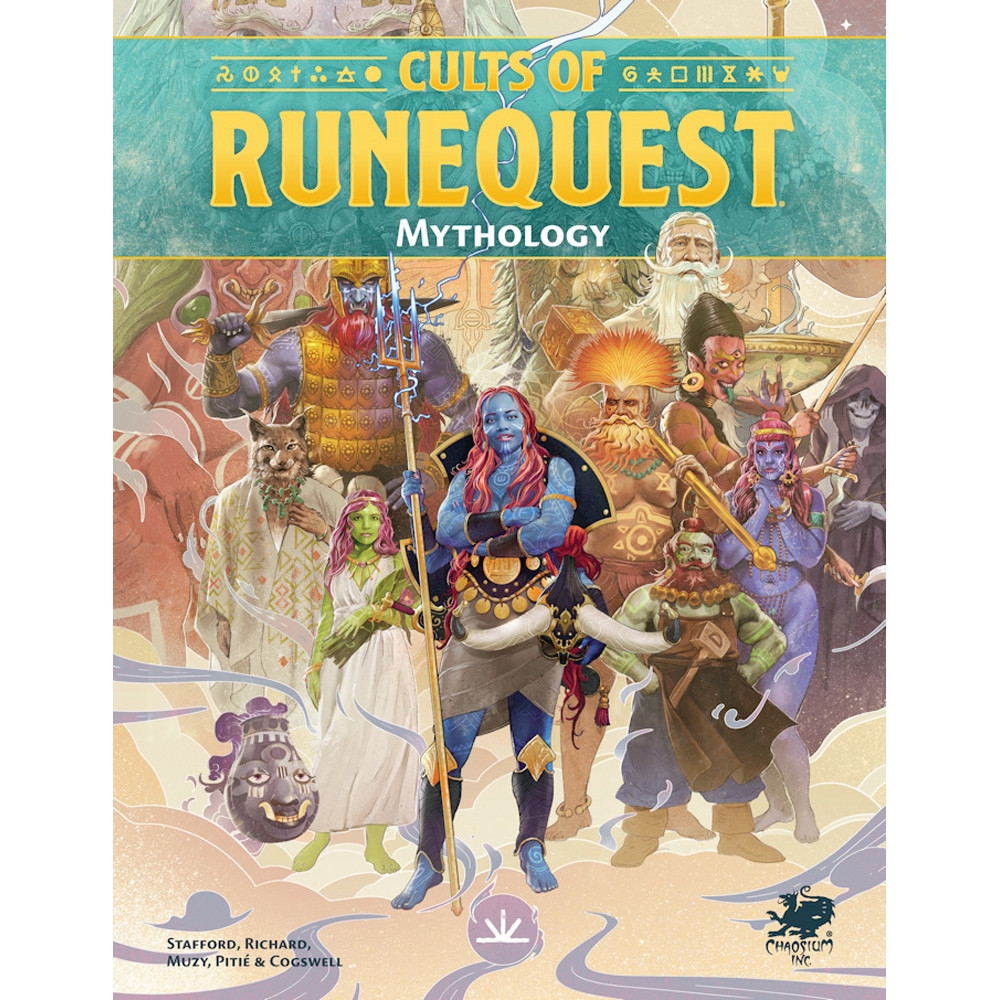I am not actively running a RuneQuest campaign right now, and yet I’ve probably gotten more out of the Cults of Runequest series than any other RPG book I’ve read this year. The reason being is I’ve ended up treating them, like I treated my well-worn childhood copy of D’Aulaires Book of Greek Myths and have been reading each book at night a little at a time, almost like an existing ancient mythology, but it is a created one from our life time, and I think that’s the point.
The Cult of RuneQuest books do contain game-related information (Mythology for example contains information on Universal Cults and Spell application), but for the most part these are the religions of Glorantha, region by region how they apply, how they connect, and overlap. In short this maybe the most monumental RPG project I’ve ever witnessed, so far as giving background to a universe. In EuroCultAV’s first reviews of the CoG books we reviewed books 2 and 3 “The Lightbringers” and “The Earth Goddesses”, continuing that backward trajectory. For this review I will be reviewing books 1 and 4 The Prosopaedia and the 4th book Mythology, to keep this out-of-sequence-ness going I’ll be reviewing the 4th book “Mythology” first out of the pair.
As an aside this might not seem as contradictory as it first seems as the book on first reading was seemingly prepped to be the first in the series. Further, I think reviewing the series in this sequence actually works quite well. The 2nd and 3rd books are complementary cults and their mythologies work in service of one another. However, the 4th book Mythology is a guide to the mythologies of all the cults of Glorantha, and the Prosopaedia is an encyclopedia of Gloranthan mythological entities (more on that later), as such I feel like these almost act in relation to one another.

Mythology surprised me right from the start with a wonderful foreword by Glorantha creator, the late, great Greg Stafford. Before going into the introduction (where in the first sentence this is introduced as the first book). The introduction goes into the meaning of mythology as it is applied here, before going into cults, the Gloranthan nature of time and magic. There is also a primer on Gloranthan Cosmology, and a section on HeroQuesting, and the runes themselves.
The next major section is based upon The “Monomyth”. This is basically an artificially created mythology that was agreed upon by scholars of an earlier age that was an attempt to bring the converging mythologies of Glorantha together. It mentions in a brief aside that the God’s names used here will be the ones popularized by the God Learners Monomyth before going into various mythologies themselves starting with 3 about creation. The next section is vastly important though short, and goes into the understanding of mythology, how it should be experienced, guidelines for cults how it applies in the world, and various notes about the gods. One of the most interesting sections comes next in “Mythic Maps”. This section first details its usage, and then goes map by map which are organized by era. These will help the reader identify the location of events not just by geography, but also by time. The next section is a catalogue of the gods, going into the various Pantheons and their genealogies. The book ends with sections on the Universal format for cults (should you I assume want to create your own, a section on Spirit Magic, and the distribution of cults around central Genertela.
The Prosopaedia is the book that as of now I’ve gotten the least out of. This is not to say it isn’t AMAZING, it is. But this is literally an encyclopedic reference to the mythological entities of Glorantha (Gods, Goddesses, heroes, spirits, and so on). Each section (where applicable) contains the name of the entity, any associated runs, common pronunciation of the name, pantheons of importance, and any associate articles that might offer some depth to the reference. Followed by a short article itself. For a Goddess like Ernalda the article could fill a third to a half of a page, for one like Jaskal it might be a short paragraph.
If I were running a game, I could see this being very useful. However, what I did end up doing with the Prosopaedia was while reading Mythology, and also going back to the Lightbringers and Earth Goddesses books was use it as a reference to section in all 3 books where I wanted to “know more” about what I was reading, almost like additional foot notes. Almost like an expansion of what I was reading on each section (my end table was basically dedicated to RuneQuest for about a month).
As I haven’t commented on this yet, one of THE most important facets of these books is the artwork. All the art for the Prosopaedia is done by Katrin Dirim, and for Mythology we have Dirim alongside Loic Muzy, and Agatha Pitie. The art across both books is absolutely deep, fantastic, and helps realize the setting and the myths the books are trying to convey. What Greg Stafford, Jeff Richard, and the team at Chaosium are doing with these books is nothing short of brilliant, and The Prosopaedia and Mythology, have to come highly recommended, not just the depth they add to Glorantha, but for sheer readability and entertainment value.

